I realize that these blogs can seem like one non sequitur after another, but such is my harp guitar life.
For instance, I was reminded again of the Hedges tuning conundrum after getting another of the old Hedges Dyer “posters” (to sell on HGM), and also a note from one of the Holloway buyers, who mentioned hoping to play Hedges. Without having to say so, this invariably means playing the tune Because It’s There.
So we should be able to simply take our Holloway, or Dyer, or other fine custom copy and tune and go, right? Well, not exactly.
If you’re reading this, you probably already know that Hedges created his own unique tuning in order to play the specific sub-bass riff of the tune; this is a sort of re-entrant tuning – meaning it’s not a normal linear scale up or down, but goes down, then up, then down again (descending D-A-C-Bb-G). The issue is then what strings to use to play his song(s) if you want to play other HG tunes.
Stacy Hobbs once had two Dyers specifically so he could play his normal material on one, and on the other, just the single Hedges piece. Too much trouble? I suppose that depends on how authentic and/or musical you want to be (not to mention concerns about string tension on your prize instrument).
I don’t know if Holloway has a Michael Hedges model planned (well, I wouldn’t say, in any event), but I’ve been thinking about how to offer such an item while Scott was still riding skateboards…;)
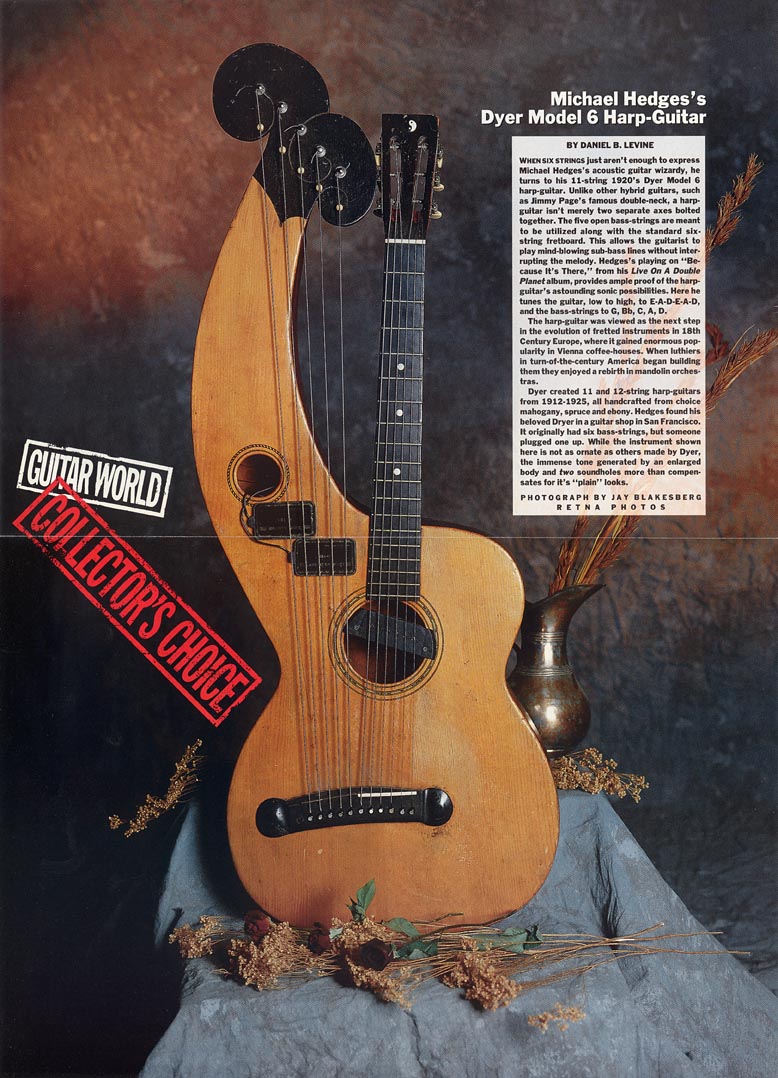
The problem is: How many subs? 5, right? But what if the obsessive fan wants it more authentic? The puzzle is that Hedges’ famed Dyer was a six-bass. Come again? True. I’m still a bit mystified why I seemed to be the first to discover it and point it out just two years ago, after getting one of the Hedges Dyer posters (a 2-page foldout from an old Guitar World magazine) on eBay.
(BTW, for the uninitiated, Dyers were originally all 5-bass instruments, like Knutsen’s, gradually giving way to a preferred 6-bass version around 1910)
There it was – a Style 4 with five bass strings (not a Style 6, as labeled – no binding, and note that there is no 12th fret marker – just like Stephen Bennett’s or the Holloway Model 4). Except that clearly visible is a plugged hole in the bridge where the sixth sub was. Also the patched and painted-over empty real estate on the headstock (if you think the remaining 5 tuners look wrong, or relocated, you have a good eye, but still wrong…they aren’t in the normal position of Bennett’s or many other specimens, but this position has been seen before, as in this 6-bass original specimen).
To this day, I marvel how Hedges not only dealt with the pain-in-the-butt friction tuners (we swap them out for more usable 4:1 banjo tuners), but that he wasn’t anxious to add that sixth string back in – especially after reading how he once hoped to explore the whole melody-in-the-bass, harp guitar thing. If I were a Hedges fanatic (I’m only an occasional amazed appreciator), this would keep me up nights!
It gets crazier. It seems Hedges finally got a second Dyer with 6 subs. I forget what it was tuned to, but apparently, he used that new string for a new song. Hedges lore has it (I forget if I read this on Rootwitch, or elsewhere, so cannot guarantee any of this story as fact) that after playing the 6-bass song, he would play a different guitar while his guitar tech removed the sixth sub-bass, then handed it back with 5 subs so that Michael could play B.I.T. without getting (visually) confused. They presumably went through this routine for every show!
Hey, whatever works. I remember Andy McKee at HGG5 quickly re-stringing his subs with different gauges in the green room because he wanted to play a certain song for us in that night’s show.
So that’s a recap of the background of this legendary instrument.
Now back to the matter at hand. Should a Hedges-only harp guitarist get a 5-bass or 6-bass? Or both? It seems to me one could do either. It’s a no-brainer for a 5-bass Dyer (or Knutsen, or other) – simply gauge, string and tune for Because It’s There and stick with it. But the Holloway owner got me thinking…6-subs are now much more common and virtually “standard.” Not that I think we should lock ourselves into that by any means, but for the sake of reality, let’s consider the scores of 6-bass Dyers and copies out there, along with the first huge crop of Holloway instruments, which are also 6-bass.
I thought: Why not simply do a Hedges 5-bass set for these instruments? After all, it would be the most authentic – just leave the last string off! Seriously. (For true aficionados, remove the tuner, post and pin, and plug up!) I decided not to list a specific set when I realized that there are already many players doing the Hedges tune, with all manner of string gauges and nominal tuning for their other repertoire. Jeff Titus, for instance, does it with gauges that make almost no sense, but they work for his playing style and instrument (Oracle) and accommodate his tuning variations. And experience shows that there is a lot of leeway in gauges that will give a decent sound on these instruments (and without destroying them), especially when different players’ thumb attack varies so widely. So at the very least, I thought I’d post a Chart (on the HGM String page) for the 3 main options for a 6-bass Dyer (a 5-bass has different scale lengths and gauges should be tweaked accordingly).
I used the Holloway scale for the calculations, as they run from a quarter to over a half-inch longer in scale (in the current configuration) than my averaged-Dyer numbers, meaning they’d require a very slightly lighter gauge for the same pitch. From years of experience (of dozens of players, besides myself), I calculate using 28 pounds of tension per string as “ideal” or nominal, with 26 or less being “light” and 30 being “medium” (and also about the heaviest that one normally needs, and still safe). I just use the D’Addario applet, which, technically, does not work for double wound subs over the mid-.060s, but gives workable results.
Set 1: Dedicated to Because It’s There tuning only. These would be theoretically optimum, adjust for feel. Do not re-tune any strings to higher pitch.
| String | 6th bass | 5th bass | 4th bass | 3rd bass | 2nd bass | 1st bass |
| Pitch | NA | G | Bb | C | A | D |
| Gauge | (leave off) | .076″ | .064″ | .059″ | .076″ | .056″ |
Set 2: For alternating between Standard Tuning and Hedges. In this case, starting with Standard Tuning, you simply omit playing the low string for Hedges, leave the G & D alone, tune the 3rd and 4th string up a half step and the 2nd string down 3 steps. I used a “medium” 30 pounds for the 2nd string so that the standard C would be at a safe max, while the Hedges’ A will have 21 pounds of tension – a bit slack, but should work with the right touch. The 3rd and 4th are gauged to give 25 or 29 pounds for the 2 different pitches.
| String | 6th bass | 5th bass | 4th bass | 3rd bass | 2nd bass | 1st bass |
| Pitch | F/unused | G | A/Bb | B/C | C/A | D/D |
| Gauge | .085″ | .076″ | .064″ | .060″ | .064″ | .056″ |
Set 3: For alternating between Stephen Bennett Tuning and Hedges. Simply shift the Hedges strings down one, and ignore the high Bennett G next to the neck. Gauges are a bit different than above, as lengths are now longer. The C/A (now the 3rd string) will here have either 29 or <21 pounds of tension. The 4th and 5th are similar to the above example ranging from 26 to 30.5 pounds for the 2 different pitches. The G can be anything from the very light .070” (the highest D’Addario goes) to an .076” (what SB uses, as it’s perfect for G and will go down to E when needed).
| String | 6th bass | 5th bass | 4th bass | 3rd bass | 2nd bass | 1st bass |
| Pitch | G | A/Bb | B/C | C/A | D/D | high G/ unused |
| Gauge | .070-.076″ | .064″ | .058 or .59″ | .060″ | .054″ or .055″ | .042″ |
Hey, I’ve never played Hedges, I’m just geeking out because someone had to do this! Hope it helps.

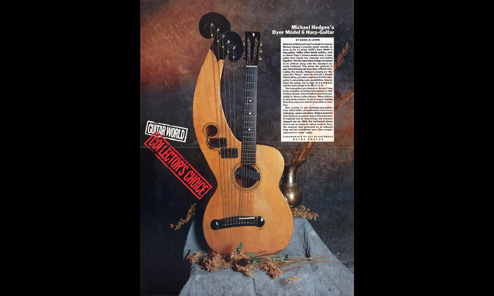
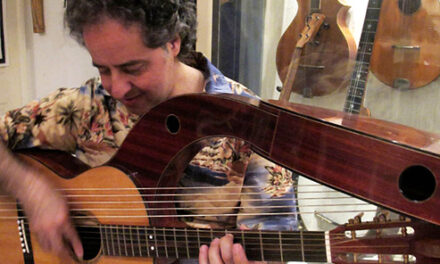
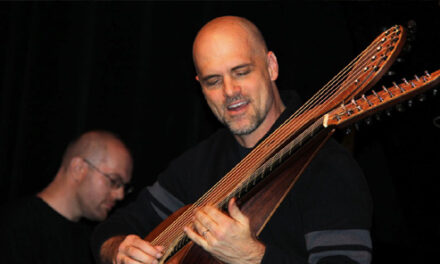
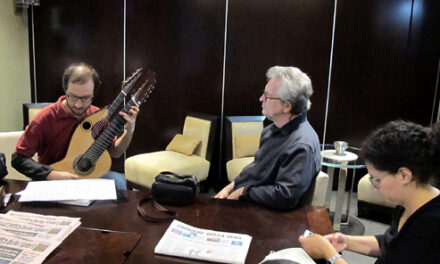
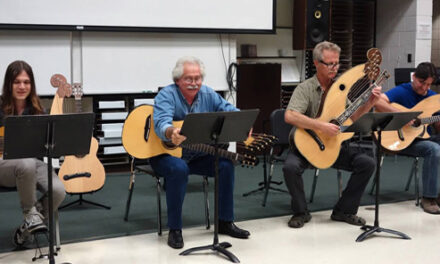
Gregg,
Not to add to all the Hedges confusion, but I thankfully caught Michael Hedges at The Bottom Line in New York City in November of ’97 right before his unfortunate accident, and if I can recall correctly, Michael played several of his harp-guitar songs (including Because It’s There) on his old Gibson Harp Guitar(multiple cracks and all!). He didn’t have a Dyer with him that night. I remember speaking briefly with Michael’s tech that night, who was a very nice woman. She even gave me one of Michael’s picks from that evening’s performance (a Fender heavy). Anyway, in my opinion, 10 subs, 6 or 5; I’m not sure it mattered much to Michael which harp guitar he played his compositions on- just as long as he got his songs across to us. (and man, did he ever!)Thanks for listening, Werner
called you several weeks ago about a harp guitar…..finally got Scott to let go of a model 4…got your christmas ornament mini harp…looks just like my real one..now I have to learn how to play it!!…you were very gracious with a new comer…thanx for helping me find a new challenge.
As always, great info Gregg. Whatever is needed to get the sound out of my head I will try it. I wish I had 5 Dyers so I could keep them all with speciic tunings, specific strings on each one as I need them. I don’t, but I do have two. A Merrill and a Holloway. Unless I want to sit back stage or during a break and change all the frickin strings around, I am limited to playing only a couple tunes at gigs on the Holloway and only one on the Merrill. But thats the way it is with me. There are no rules, and as Michael Hedges preached it, he practiced all he preached on the subject of discovery. I struggled a long time with the ‘box’ of things.. All I can say is that the more often I pick up the Harpguitar the more expanding my playing becomes. Having a 5 string or six string hg,.. whatever works.. However you need to set it up to get the job done. I would imagine taking Because Its There, with the 6th sub base string and fooling around to see what could happen. No rules apply.
Would Michael be pleased with an altured or expanded version of Because Its There? Hell yes he would! I am a HUGE fan of Hedges. He offered a galaxy of ideas and techniques for us to use. My good pal Ramblin Jack Elliott told me,,more then once, to “Take the song your playing and own it for 5 mintes”. Expand on a song that someone else wrote, adding or trying to add my own style or signature to a Hedges or a Bennit instrumental is more exciting to me then just playing their tune note for note as they wrote it.. How boring that is.. Challanging but intensly boring, to me. If some Hedges fanatic comes up to me and says, “well gee, you didnt play that song like Michael, or, as someone reciently refered to the Stropes book on some hedges tune, I just respond by saying, “your right”, I don’t play it exact to how they play it. Don’t want to”. Besides, reading tabs just gives me a head ache…
And thanks again for the blog on this.. As all your blogs are very helpful. Sooo much to learn.. Cheers, Doug
Great stuff Gregg! As others have said, I’ve found myself looking forward
To reading the blog everyday. Interesting Hedges info today.
Thank you,
Mike